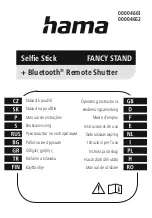
In other cases, input methods provide you with gestures and key combinations for languages. Some keyboard input
methods are common to all supported languages, such as word prediction or selecting accented characters by pressing
and holding keys.
All keyboard input methods also support using
key to access symbols.
You can use your BlackBerry device in many different languages, regardless of the default language you select. However,
the differences between the languages you use may mean that you need specific tips to use your BlackBerry Keyboard with
a language that is different than the default keyboard layout. For example, if you use a language that has more characters
in the alphabet than the language that your keyboard supports, you need to know how to access those additional
characters.
Typing in other languages
You can set your BlackBerry device to recognize three different input languages when you type. As you type, your device
makes predictions based on each of the language families. For example, if you use a Latin-based display language,
predictions appear for any of the configured Latin-based languages. Similarly, if your display language is Korean, it will not
display Arabic or Latin-based suggestions. When you set more than one typing language, you may need to consider the
following:
• Some languages, such as Thai and Arabic, have more characters in the alphabet than there are keys on the keyboard.
You need to use a keystroke combination to access the second or third character on a particular key. For information
about how to access these types of characters, see the help for typing in that language.
• Different languages may have different keyboard layouts. For example, American English uses a QWERTY keyboard
layout, but French uses an AZERTY keyboard layout. Some keys appear in locations that you may not be used to.
• Similar languages may have slightly different keyboard layouts. For example, many languages use a QWERTY keyboard
layout. However, Danish, Spanish, and Romanian include different characters on the basic keyboard that aren't on
other QWERTY keyboard layouts.
• Some supported languages, such as Hebrew, Farsi, and Arabic, read right-to-left. If you change to one of these
languages from a left-to-right language in the middle of a sentence, your device automatically places the characters
you type on the left side of the cursor. When you change back to the left-to-right language, you need to move your
cursor back to the right side of the text.
Typing in Arabic or Farsi
The Arabic and Farsi keyboard layouts support the following features:
• The Arabic language has more characters in the alphabet than there are keys on the keyboard. As a result, more than
one native character appears on one key. There may be alternate letters that are related to a primary letter or have a
similar form. You can use the keyboard mapping guide that appears with the typing task to determine how to press and
hold a letter or multi-press to access the second and third characters on each key.
• The Farsi language has a few characters that are different from the basic Arabic alphabet. These characters are listed
on the keyboard mapping guide.
• Word prediction and flicking word suggestions up onto the screen (if you have this feature turned on)
• You can type alternate characters and diacritics in two ways. You can press
and press a letter. A second method is
to press and hold the primary character. Then, select the alternate character from the options.
User Guide
Settings
179
















































